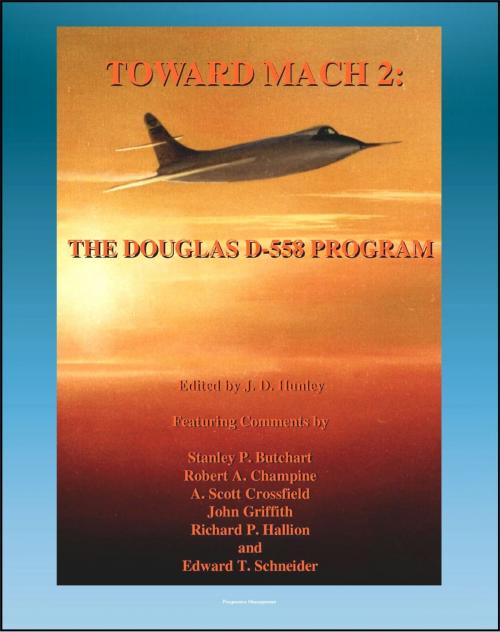Toward Mach 2: The Douglas D-558 Program - Skystreak and Skyrocket Early Transonic Research Aircraft (NASA SP-4222)
Nonfiction, Science & Nature, Technology, Military Science, History, Military, Aviation| Author: | Progressive Management | ISBN: | 9781465850744 |
| Publisher: | Progressive Management | Publication: | March 3, 2012 |
| Imprint: | Smashwords Edition | Language: | English |
| Author: | Progressive Management |
| ISBN: | 9781465850744 |
| Publisher: | Progressive Management |
| Publication: | March 3, 2012 |
| Imprint: | Smashwords Edition |
| Language: | English |
This official NASA history report - converted for accurate flowing-text e-book format reproduction - provides a history of research with the D-558 Skystreak and Skyrocket supersonic airplane at NASA's Dryden Flight Research Center in California.
In the long and proud history of flight research at what is now called the NASA Dryden Flight Research Center, the D-558 project holds a special place as being one of the earliest and most productive flight research efforts conducted here. Data from the D-558 and the early X-planes enabled researchers at what became NASA's Langley Research Center to correlate and correct test results from wind tunnels with actual flight values. Then, the combined results of flight and wind-tunnel testing enabled the U.S. aeronautical community to solve many of the problems that occur in the transonic speed range (about 0.8 to 1.2 times the speed of sound), such as pitch-up, buffeting, and other instabilities. This enabled reliable and routine flight of such aircraft as the century series of fighters (F-100, F-102, F-104, etc.) as well as all commercial transport aircraft from the mid-1950s to the present.
At the symposia honoring the 50th anniversary of the D-558-1 Skyrocket's first flight in February 1948, four D-558 pilots — Stanley P. Butchart, Robert A. Champine, A. Scott Crossfield, and John Griffith — plus Air Force Historian Richard Hallion offered insightful comments and meaningful anecdotes that deserved a wider audience than the few hundred people who attended. To make their recollections and related documents available to such an audience, NASA is publishing this volume.
The Douglas D-558-1 Skystreak and D-558-2 Skyrocket were, with the Bell XS-1, the earliest transonic research aircraft built in this country to gather data so the aviation community could understand what was happening when aircraft approached the speed of sound (roughly 741 miles per hour at sea level in dry air at 32 degrees Fahrenheit). In the early 1940s, fighter (actually, in the terms of the time, pursuit) aircraft like the P-38 Lightning were approaching these speeds in dives and either could not get out of the dives before hitting the ground or were breaking apart from the effects of compressibility—increased density and disturbed airflow as the speed approached that of sound and created shock waves.
At this time, aerodynamicists lacked accurate wind-tunnel data for the speed range from roughly Mach 0.8 to 1.2 (respectively, 0.8 and 1.2 times the speed of sound, so named in honor of Austrian physicist Ernst Mach, who — already in the second half of the 19th century — had discussed the speed of a body moving through a gas and how it related to the speed of sound). To overcome the limited knowledge of what was happening at these transonic speeds, people in the aeronautics community — especially the National Advisory Committee for Aeronautics (NACA), the Army Air Forces (AAF — Air Force after 1947), and the Navy — agreed on the need for a research airplane with enough structural strength to withstand compressibility effects in this speed range. The AAF preferred a rocket-powered aircraft and funded the XS-1 (experimental Supersonic, later shortened to simply X), while the NACA and Navy preferred a more conservative design and pursued the D-558, with the NACA also supporting the X-1 research.
This official NASA history report - converted for accurate flowing-text e-book format reproduction - provides a history of research with the D-558 Skystreak and Skyrocket supersonic airplane at NASA's Dryden Flight Research Center in California.
In the long and proud history of flight research at what is now called the NASA Dryden Flight Research Center, the D-558 project holds a special place as being one of the earliest and most productive flight research efforts conducted here. Data from the D-558 and the early X-planes enabled researchers at what became NASA's Langley Research Center to correlate and correct test results from wind tunnels with actual flight values. Then, the combined results of flight and wind-tunnel testing enabled the U.S. aeronautical community to solve many of the problems that occur in the transonic speed range (about 0.8 to 1.2 times the speed of sound), such as pitch-up, buffeting, and other instabilities. This enabled reliable and routine flight of such aircraft as the century series of fighters (F-100, F-102, F-104, etc.) as well as all commercial transport aircraft from the mid-1950s to the present.
At the symposia honoring the 50th anniversary of the D-558-1 Skyrocket's first flight in February 1948, four D-558 pilots — Stanley P. Butchart, Robert A. Champine, A. Scott Crossfield, and John Griffith — plus Air Force Historian Richard Hallion offered insightful comments and meaningful anecdotes that deserved a wider audience than the few hundred people who attended. To make their recollections and related documents available to such an audience, NASA is publishing this volume.
The Douglas D-558-1 Skystreak and D-558-2 Skyrocket were, with the Bell XS-1, the earliest transonic research aircraft built in this country to gather data so the aviation community could understand what was happening when aircraft approached the speed of sound (roughly 741 miles per hour at sea level in dry air at 32 degrees Fahrenheit). In the early 1940s, fighter (actually, in the terms of the time, pursuit) aircraft like the P-38 Lightning were approaching these speeds in dives and either could not get out of the dives before hitting the ground or were breaking apart from the effects of compressibility—increased density and disturbed airflow as the speed approached that of sound and created shock waves.
At this time, aerodynamicists lacked accurate wind-tunnel data for the speed range from roughly Mach 0.8 to 1.2 (respectively, 0.8 and 1.2 times the speed of sound, so named in honor of Austrian physicist Ernst Mach, who — already in the second half of the 19th century — had discussed the speed of a body moving through a gas and how it related to the speed of sound). To overcome the limited knowledge of what was happening at these transonic speeds, people in the aeronautics community — especially the National Advisory Committee for Aeronautics (NACA), the Army Air Forces (AAF — Air Force after 1947), and the Navy — agreed on the need for a research airplane with enough structural strength to withstand compressibility effects in this speed range. The AAF preferred a rocket-powered aircraft and funded the XS-1 (experimental Supersonic, later shortened to simply X), while the NACA and Navy preferred a more conservative design and pursued the D-558, with the NACA also supporting the X-1 research.















